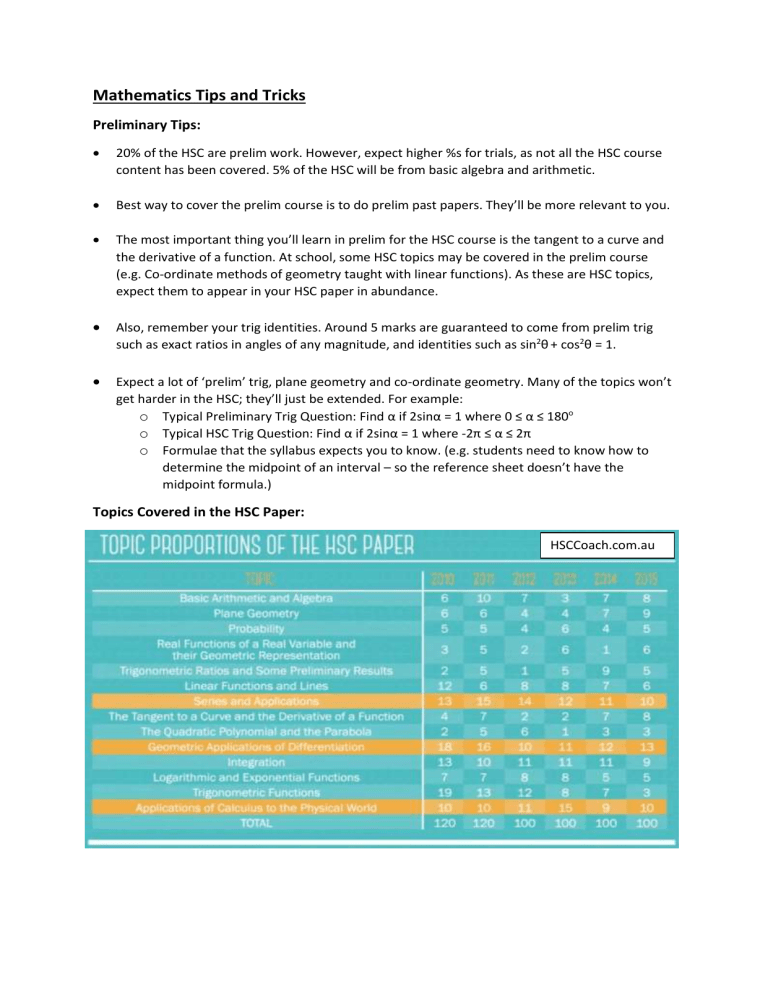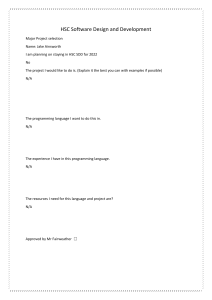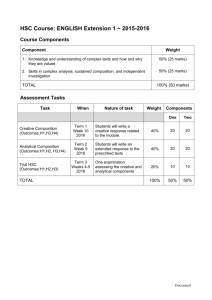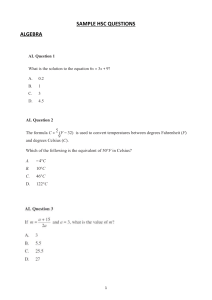
Mathematics Tips and Tricks Preliminary Tips: 20% of the HSC are prelim work. However, expect higher %s for trials, as not all the HSC course content has been covered. 5% of the HSC will be from basic algebra and arithmetic. Best way to cover the prelim course is to do prelim past papers. They’ll be more relevant to you. The most important thing you’ll learn in prelim for the HSC course is the tangent to a curve and the derivative of a function. At school, some HSC topics may be covered in the prelim course (e.g. Co-ordinate methods of geometry taught with linear functions). As these are HSC topics, expect them to appear in your HSC paper in abundance. Also, remember your trig identities. Around 5 marks are guaranteed to come from prelim trig such as exact ratios in angles of any magnitude, and identities such as sin2θ + cos2θ = 1. Expect a lot of ‘prelim’ trig, plane geometry and co-ordinate geometry. Many of the topics won’t get harder in the HSC; they’ll just be extended. For example: o Typical Preliminary Trig Question: Find α if 2sinα = 1 where 0 ≤ α ≤ 180o o Typical HSC Trig Question: Find α if 2sinα = 1 where -2π ≤ α ≤ 2π o Formulae that the syllabus expects you to know. (e.g. students need to know how to determine the midpoint of an interval – so the reference sheet doesn’t have the midpoint formula.) Topics Covered in the HSC Paper: Spend a good portion of your time looking at series, differentiation (especially with HSCCoach.com.au regard to geometry) and calculus. Textbooks: Try and use two different textbooks if you can – they will explain topics differently and provide different examples. Cambridge Mathematics 2 Unit 2nd edition Maths in Focus 2nd edition New Senior maths 2nd edition Excel/ Pascal Press Study Guides (supplementary) Getting to Know Your Formula Sheet: Familiarise yourself with the stuff that’s not on this sheet. These are: o Formulae that’s been derived from a formula that’s already on the reference sheet. (e.g. sinθ2 + cosθ2 = 1 is on the sheet, but 1 - tanθ2 = sec θ2 is not.) What Markers Look For: Work! Markers are constantly looking to give away marks, so leaving an answer blank or without sufficient working won’t help anybody. You’ll get marks for crossed out work as long as the marker can read it. If your final answer was not worth full marks, markers will look at any previous attempts. Your substitution! Usually, you will get marks for straight-in substitution, but not for your answer. Don’t try and be smart and do stuff in your head. It might look really stupid, but that’s what will show the marker that you know what you’re doing. Calculations! Markers will award marks for a correct calculator input/ output, so it’s important to write these numbers down fully. Round at the end. A boxed, circled or highlighted answer. Make it clear. If you’ve found the answer to a variable which needs to substituted back into the question, label the answer accordingly. ½ page diagrams, drawn with a ruler/ compass/ mathaid. The bigger, the better – they’ll help you know what you’re doing and allow the marker to see what you’re doing. Annotate your drawn diagrams, specifying them in your working (e.g. as in the diagram, line ab is produced to point k so that ab = bk). Don’t forget axes labels, especially when drawing derivative graphs with f’(x) on the vertical axis. Don’t divide the page into columns. However, don’t work across either. Work your way down the page. If you screw something up, then use the right-hand side of the page and indicate that that’s where your new work reads. To get a Band 6: By experience, a band 6 student should finish the paper with >30 mins to spare (I gave myself a 2-hour time limit when doing trials) and not have to check the reference sheet at all. To get a band 6, the most important criteria is to ‘integrate ideas of calculus with strong algebraic skills’. Master your algebra. Skilful and innovative algebraic manipulation is usually all it takes to get those last few marks. The discriminator of Band 6s is the annuities and superannuation topic. This topic makes about 6% of the paper. Since the formulae used are not on the reference sheet, most kids will skip these. Practice! 2U is one of the only subjects where > 90% of the exam is predictable. Look at past HSC papers from NESA and other school trials. In fact, 50% of the HSC is calculus-based (15% of the paper is geometry and calculus). The markers’ comments are your best friend. Poorly done questions are often repeated. Study different topics as one. Learn all the different instances of a topic (e.g. parabolas, cubics, hyperbolas, exponentials and linear functions as functions). This is so you are ready for exam questions which integrate different topics together or have multiple components and ask for a similar approach/ mentality for each part. In other words, group your content when you study: treat all functions as functions, all trig ratios as trig ratios (and not separate ratios), etc. Remember that the harder questions of the 2U paper are considered average 3U questions. The 2U maths paper really favours kids who do higher levels of maths – that is, the more maths you do, the easier the easier papers will be. ‘Go with the flow’. Start somewhere and the maths will take you wherever you need to be. General Hints for Doing Exams: Do the paper in order. Always (in 2U, at least) Read each question at least twice and highlight key words (e.g. exact value) on the 2nd read. Also, highlight important things that you might otherwise overlook. (e.g. ABCD is a square). Don’t pre-label your page. Label each question as you go Tick each question as you go. When you’re stressed, there’s a higher likelihood to skip stuff. Write in pen. Papers get scanned and pencil is notoriously hard to read. You can do your diagrams in pencil, though I went over mine in pen once it looked good. The first questions will always test for rounding to significant figures or scientific notation. However, ensure that all your answers have the full calculator output (or some figures truncated with an ellipsis) before rounding off to the smallest number of decimal places offered in the question. Specify how many places this is. IMPORTANT! Don’t ‘fudge’ answers so that the look right (or so they equal what the question wants (e.g. show that…)). In many cases, you’ll lose 1 mark for each mathematical error, so that’s one gone for screwing up the first time and another for changing it. You’re better off getting an incorrect answer and moving to the next part with the given number. Even if you can’t get the first part, make a number up! You’re awarded for logic, so carry-on error applies and you’re still eligible for full marks in that section. Exam Technique Time Management (A general guide for a high Band 6): Reading time MCQs (Q 1-10) Question 11 Question 12 Question 13 Question 14 5 mins 10 mins. May have one tricky but move on now – lots of time later! Aim for about 6 minutes. Watch out for sillies! 10-12 minutes – Usu Coord. Geom Q + some prelim content 12-15 minutes – Harder integration like areas/ volumes. Lots of trig 15-25 mins – Rates of change. Logs and expos. Simpson/trap rule Questions 15 Question 16 Check Paper 20-25 mins – A real tricky probability q. More rates, graph work. 25-35 mins. Take it slow! Generally annuities and tricky geo. 40 minutes (or maybe more!) Depends how hard the last question is In reading time: Look at the MCQs. If you can do them, make sure you get them out of the way once the exam starts. If you can’t do them, make sure you skip them, and allow time to come back later. Read the rest of the paper really carefully (don’t scan, you have 5 whole minutes). Look at the number of questions/ parts, as well as the topics covered. Do some multiple-choice questions in your head, hold the answer and transfer it when the time comes. If you can’t do any more MCQs without working, spend any extra time thinking about the last few questions (especially if you are doing higher levels of maths). Multiple Choice Questions: Work out the answers to the questions without looking at the answers (unless they have diagrams). Wrong answers are extremely tempting. Test all solutions, if you can’t find the answer. Trial and error each one – option A might look good but we don’t know if it’s the best answer unless we look at the other 3 options. If you cannot do guess and check, eliminate incorrect solutions before ‘guessing’. Multiple choice questions tend to come in ‘pairs’: that is, one pair of answers may have the same symbol, or a similar denominator, or even a like term. The other pair will be similar to each other, but not with the first pair. (e.g. a) 1/2 b) -7/5 c) -1/2 d) -9/5) Eliminating a pair is certainly easier than eliminating one of 4 options, because it will usually take only half the time to do. Spend no longer than 18 minutes (10% of 3 hours) on the MCQs. Aim for 15 minutes, so you have time to complete the harder questions. Due to the nature of their marks, MCQs are a great place to create time for harder questions. You can come back to any MCQ which should be worth 2 – 3 marks. Always start with the MCQs. Use them as a warmup -the first few are meant to be easy. Remember that all MCQs are worth one mark, and therefore require no working. This is an opportunity to use legal ‘cheat’ methods to your advantage. This especially applies to limits, where you can easily substitute a number close to your limit and see where your calculator takes you. However, do not rely on this method when doing past papers, as it is common to find past HSC MCQs in more recent short answer questions. Questions 11 – 16 Questions 11, 12 and 13 are ‘bread and butter’ questions. These are 45 marks which should be very easy to get. Parts labelled i), ii), iii), iv) etc. will always be linked. It’ll be very hard to complete part iv) without completing the previous parts. However, if you cannot complete an earlier part, ensure something is written down for all parts. Perhaps write a formula or ratio down somewhere… Make sure you qualify any step that you do, as the marker cannot infer. For example, ∴ length is 5 metres, as a negative length cannot exist. Most of the last questions will have geometry, similarity, trigonometry, and calculus. These questions are gaining popularity as there are no set formula to simply substitute. There’s a lot of critical thinking involved in these questions; often ‘outside the box’. Always ‘suspect’ integrated topics in harder questions. Things in the end of the paper will either spread over a number of areas (trig and max/min, plane geometry and series), or like in the 2018 HSC, integrate different sections in the same area, like simultaneous arithmetic and geometric series, or superannuation and time payment. Isolating each part first is a foolproof first step. Establishing how each part affects the other will often leas successful trains of thought. These last (geometry/calculus) questions are normally broken into 4 parts. o Identifying the relationship between different variables, or assigning values using simple formulae. E.g. Show that x is equal to 25√2 o Expressing one term as another. E.g. Hence, find the value of α2 in terms of β. o Differentiate, using values from parts i) and ii) o Evaluate minimums and/ or maximums using the differentiation of part iii) Harder questions will have the most disgusting calculus. Prevail! (importantly, remember not to count any variables that don’t matter – they’re constants until you give them meaning). General tips and thoughts The HSC is just like the trials, but usually, expect to find a ‘spanner in the works’. That is, questions with an unforeseen complication that you didn’t see in the trials. Motion is generally where you’ll be tested on conceptual understanding as much (if not more) than subbing numbers into formulas. Know what the graphs do, and the significance of deriving/ integrating. Expect to find congruence questions at the start of the paper, and similarity questions (combined with some trig and calculus) towards the end. See section above. The last mark of a minimum differentials question is reserved for a check of the answer. Therefore, it’s a good idea to consciously and obviously show that all your values (for any relevant question) has been checked. If in doubt, think about what topic(s) the question might be referring to. Identifying one alone (by writing a relevant formula and substituting as many values as you can) might be a free mark. Question/topic-specific tips Know your product, quotient and function-of-a-function rule back to front! I remembered them as words and wrote the answer as I went (e.g. diff the first, leave the 2nd plus leave the second, diff the first) – if you know what you’re doing, it’ll save you plenty of time! Some teachers tell their students to use the formula sheet’s Simpson’s rule twice when the opportunity arises. Using shortcuts like the one below for the Simpson’s rule will greatly improve efficiency. (markers won’t mark you down for being efficient, as long as you provide all working): 𝑏 ∫ 𝑓 (𝑥 ) ⅆ𝑥 ≈ 𝑎 ℎ [(𝑦 + 𝑦𝑏 ) + 4(𝑦𝑜𝑑𝑑𝑠 ) + 2(𝑦𝑒𝑣𝑒𝑛𝑠 )] 3 𝑎 HSC probability = year 10 probability. Often overlooked, this is the worst done section of the HSC. [2018 was a shocker!] Make sure you go over your year 10 notes. Be mindful of the main points asked in HSC probability questions: o When there is an ‘at least’ question (e.g. what is the probability that at least one of the 3 runners will finish in 10 minutes?), find the probability of the complementary event and go 1 – P (one minus the complementary probability) to get your answer. In this example, what is the probability that all runners will not finish in 10 mins. Multiply for ‘and’ and add for ‘or’. o Please don’t underestimate the power of the tree diagram and outcome table!





